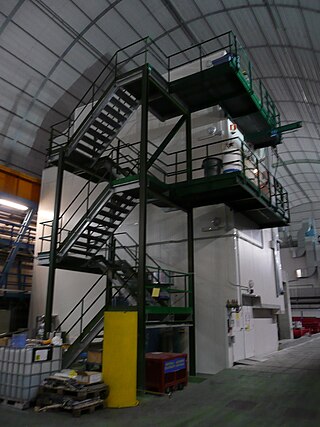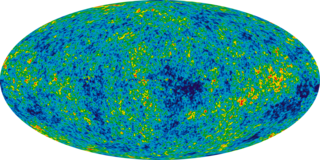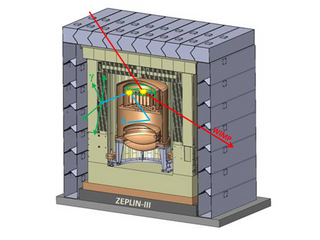Related Research Articles
Weakly interacting massive particles (WIMPs) are hypothetical particles that are one of the proposed candidates for dark matter.
The DAMA/NaI experiment investigated the presence of dark matter particles in the galactic halo by exploiting the model-independent annual modulation signature. Based on the Earth's orbit around the Sun and the solar system's speed with respect to the center of the galaxy, the Earth should be exposed to a higher flux of dark matter particles around June 1, when its orbital speed is added to the one of the solar system with respect to the galaxy and to a smaller one around December 2, when the two velocities are subtracted. The annual modulation signature is distinctive since the effect induced by dark matter particles must simultaneously satisfy many requirements.
The Cryogenic Dark Matter Search (CDMS) is a series of experiments designed to directly detect particle dark matter in the form of Weakly Interacting Massive Particles. Using an array of semiconductor detectors at millikelvin temperatures, CDMS has at times set the most sensitive limits on the interactions of WIMP dark matter with terrestrial materials. The first experiment, CDMS I, was run in a tunnel under the Stanford University campus. It was followed by CDMS II experiment in the Soudan Mine. The most recent experiment, SuperCDMS, was located deep underground in the Soudan Mine in northern Minnesota and collected data from 2011 through 2015. The series of experiments continues with SuperCDMS SNOLAB, an experiment located at the SNOLAB facility near Sudbury, Ontario, in Canada that started construction in 2018 and is expected to start data taking in early 2020s.
The XENON dark matter research project, operated at the Italian Gran Sasso National Laboratory, is a deep underground detector facility featuring increasingly ambitious experiments aiming to detect hypothetical dark matter particles. The experiments aim to detect particles in the form of weakly interacting massive particles (WIMPs) by looking for rare nuclear recoil interactions in a liquid xenon target chamber. The current detector consists of a dual phase time projection chamber (TPC).

The UK Dark Matter Collaboration (UKDMC) (1987–2007) was an experiment to search for Weakly interacting massive particles (WIMPs). The consortium consisted of astrophysicists and particle physicists from the United Kingdom, who conducted experiments with the ultimate goal of detecting rare scattering events which would occur if galactic dark matter consists largely of a new heavy neutral particle. Detectors were set up 1,100 m (3,600 ft) underground in a halite seam at the Boulby Mine in North Yorkshire.
The ArDM Experiment was a particle physics experiment based on a liquid argon detector, aiming at measuring signals from WIMPs, which may constitute the Dark Matter in the universe. Elastic scattering of WIMPs from argon nuclei is measurable by observing free electrons from ionization and photons from scintillation, which are produced by the recoiling nucleus interacting with neighbouring atoms. The ionization and scintillation signals can be measured with dedicated readout techniques, which constituted a fundamental part of the detector.

DEAP is a direct dark matter search experiment which uses liquid argon as a target material. DEAP utilizes background discrimination based on the characteristic scintillation pulse-shape of argon. A first-generation detector (DEAP-1) with a 7 kg target mass was operated at Queen's University to test the performance of pulse-shape discrimination at low recoil energies in liquid argon. DEAP-1 was then moved to SNOLAB, 2 km below Earth's surface, in October 2007 and collected data into 2011.

The Cryogenic Rare Event Search with Superconducting Thermometers (CRESST) is a collaboration of European experimental particle physics groups involved in the construction of cryogenic detectors for direct dark matter searches. The participating institutes are the Max Planck Institute for Physics (Munich), Technical University of Munich, University of Tübingen (Germany), University of Oxford, the Comenius University Bratislava (Slovakia) and the Istituto Nazionale di Fisica Nucleare.

Light dark matter, in astronomy and cosmology, are dark matter weakly interacting massive particles (WIMPS) candidates with masses less than 1 GeV. These particles are heavier than warm dark matter and hot dark matter, but are lighter than the traditional forms of cold dark matter, such as Massive Compact Halo Objects (MACHOs). The Lee-Weinberg bound limits the mass of the favored dark matter candidate, WIMPs, that interact via the weak interaction to GeV. This bound arises as follows. The lower the mass of WIMPs is, the lower the annihilation cross section, which is of the order , where m is the WIMP mass and M the mass of the Z-boson. This means that low mass WIMPs, which would be abundantly produced in the early universe, freeze out much earlier and thus at a higher temperature, than higher mass WIMPs. This leads to a higher relic WIMP density. If the mass is lower than GeV the WIMP relic density would overclose the universe.
The DAMA/LIBRA experiment is a particle detector experiment designed to detect dark matter using the direct detection approach, by using a matrix of NaI(Tl) scintillation detectors to detect dark matter particles in the galactic halo. The experiment aims to find an annual modulation of the number of detection events, caused by the variation of the velocity of the detector relative to the dark matter halo as the Earth orbits the Sun. It is located underground at the Laboratori Nazionali del Gran Sasso in Italy.

EDELWEISS is a dark matter search experiment located at the Modane Underground Laboratory in France. The experiment uses cryogenic detectors, measuring both the phonon and ionization signals produced by particle interactions in germanium crystals. This technique allows nuclear recoils events to be distinguished from electron recoil events.
The DarkSide collaboration is an international affiliation of universities and labs seeking to directly detect dark matter in the form of weakly interacting massive particles (WIMPs). The collaboration is planning, building and operating a series of liquid argon time projection chambers (TPCs) that are employed at the Gran Sasso National Laboratory in Assergi, Italy. The detectors are filled with liquid argon from underground sources in order to exclude the radioactive isotope 39
Ar, which makes up one in every 1015 (quadrillion) atoms in atmospheric argon. The Darkside-10 (DS-10) prototype was tested in 2012, and the Darkside-50 (DS-50) experiment has been operating since 2013. Darkside-20k (DS-20k) with 20 tonnes of liquid argon is being planned as of 2019.

The ZEPLIN-III dark matter experiment attempted to detect galactic WIMPs using a 12 kg liquid xenon target. It operated from 2006 to 2011 at the Boulby Underground Laboratory in Loftus, North Yorkshire. This was the last in a series of xenon-based experiments in the ZEPLIN programme pursued originally by the UK Dark Matter Collaboration (UKDMC). The ZEPLIN-III project was led by Imperial College London and also included the Rutherford Appleton Laboratory and the University of Edinburgh in the UK, as well as LIP-Coimbra in Portugal and ITEP-Moscow in Russia. It ruled out cross-sections for elastic scattering of WIMPs off nucleons above 3.9 × 10−8 pb from the two science runs conducted at Boulby.

Kim Sun-kee is a South Korean physicist. He is professor in Seoul National University and director of the Korea Invisible Mass Search. He was the first director of the Rare Isotope Science Project within the Institute for Basic Science and is a member of the Korean Academy of Science and Technology.
The Particle and Astrophysical Xenon Detector, or PandaX, is a dark matter detection experiment at China Jinping Underground Laboratory (CJPL) in Sichuan, China. The experiment occupies the deepest underground laboratory in the world, and is among the largest of its kind.

The LUX-ZEPLIN (LZ) Experiment is a next-generation dark matter direct detection experiment hoping to observe weakly interacting massive particles (WIMP) scatters on nuclei. It was formed in 2012 by combining the LUX and ZEPLIN groups. It is currently a collaboration of 30 institutes in the US, UK, Portugal and South Korea. The experiment is located at about 1,500 meteres under the Sanford Underground Research Facility (SURF) in South Dakota, and is managed by the United States Department of Energy's (DOE) Lawrence Berkeley National Lab.
The Stawell Underground Physics Laboratory (SUPL) is a laboratory 1 km deep in the Stawell Gold Mine, located in Stawell, Shire of Northern Grampians, Victoria, Australia. Together with the planned Agua Negra Deep Experiment Site (ANDES) at the Agua Negra Pass, it is one of just two underground particle physics laboratories in the Southern Hemisphere and shall conduct research into dark matter.
The CoGeNT experiment has searched for dark matter. It uses a single germanium crystal as a cryogenic detector for WIMP particles. CoGeNT has operated in the Soudan Underground Laboratory since 2009.

ANAIS is a dark matter direct detection experiment located at the Canfranc Underground Laboratory (LSC), in Spain, operated by a team of researchers of the CAPA at the University of Zaragoza.
Direct detection of dark matter is the science of attempting to directly measure dark matter collisions in Earth-based experiments. Modern astrophysical measurements, such as from the Cosmic Microwave Background, strongly indicate that 85% of the matter content of the universe is unaccounted for. Although the existence of dark matter is widely believed, what form it takes or its precise properties has never been determined. There are three main avenues of research to detect dark matter: attempts to make dark matter in accelerators, indirect detection of dark matter annihilation, and direct detection of dark matter in terrestrial labs. The founding principle of direct dark matter detection is that since dark matter is known to exist in the local universe, as the Earth, Solar System, and the Milky Way Galaxy carve out a path through the universe they must intercept dark matter, regardless of what form it takes.
References
- ↑ The Journal of the Korean Physical Society. Korean Physical Society. 2005.
- 1 2 Kiwoon Choi; Jihn E. Kim; Dongchul Son (12 December 2005). Particles, Strings and Cosmology: 11th International Symposium on Particles, Strings and Cosmology; PASCOS 2005. Springer. pp. 75–81. ISBN 978-0-7354-0295-9.
- ↑ Symmetry: Dimensions of Particle Physics. Fermi National Accelerator Lab. 2006.
- ↑ KIMS Collaboration (9 February 2006). "First limit on WIMP cross section with low background CsI(Tℓ) crystal detector". Phys. Lett. B. 633 (2–3): 201–208. arXiv: astro-ph/0509080 . Bibcode:2006PhLB..633..201K. doi:10.1016/j.physletb.2005.12.035. S2CID 12364980.
- ↑ Kim, S.C.; et al. (30 April 2012). "New Limits on Interactions between Weakly Interacting Massive Particles and Nucleons Obtained with CsI(Tl) Crystal Detectors". Phys. Rev. Lett. 108 (181301): 181301. arXiv: 1204.2646 . Bibcode:2012PhRvL.108r1301K. doi:10.1103/PhysRevLett.108.181301. PMID 22681055. S2CID 30999467.
- ↑ Lee, H.S.; et al. (23 September 2014). "Search for low-mass dark matter with CsI(Tl) crystal detectors". Phys. Rev. D. 90 (52006): 052006. arXiv: 1404.3443 . Bibcode:2014PhRvD..90e2006L. doi:10.1103/PhysRevD.90.052006. S2CID 55422611.
- ↑ Ha, Chang Hyon (20 July 2016). Status of the COSINE experiment. Identification of Dark Matter 2016. Sheffield.
- ↑ "COSINE-100 Experiment". COSINE-100 Dark Matter Experiment. Yale. Retrieved 29 October 2018.
COSINE-100 has started taking physics data on September 2016, so stay tuned for our first physics result!
- ↑ The COSINE-100 Collaboration (5 December 2018). "An experiment to search for dark-matter interactions using sodium iodide detectors". Nature. 564 (7734): 83–86. arXiv: 1906.01791 . Bibcode:2018Natur.564...83C. doi:10.1038/s41586-018-0739-1. PMID 30518890. S2CID 54459495.
{{cite journal}}: CS1 maint: numeric names: authors list (link) - ↑ Adhikari, Govinda; de Souza, Estella B.; Carlin, Nelson; Choi, Jae Jin; Choi, Seonho; Djamal, Mitra; Ezeribe, Anthony C.; França, Luis E.; Ha, Chang Hyon; Hahn, In Sik; Jeon, Eunju (2021-11-12). "Strong constraints from COSINE-100 on the DAMA dark matter results using the same sodium iodide target". Science Advances. 7 (46): eabk2699. arXiv: 2104.03537 . Bibcode:2021SciA....7.2699A. doi:10.1126/sciadv.abk2699. ISSN 2375-2548. PMC 8580298 . PMID 34757778.
- ↑ "Is the end in sight for famous dark matter claim?". www.science.org. Retrieved 2021-12-29.
- ↑ Adhikari, G.; Carlin, N.; Choi, J. J.; Choi, S.; Ezeribe, A. C.; Franca, L. E.; Ha, C.; Hahn, I. S.; Hollick, S. J.; Jeon, E. J.; Jo, J. H.; Joo, H. W.; Kang, W. G.; Kauer, M.; Kim, B. H. (2023). "An induced annual modulation signature in COSINE-100 data by DAMA/LIBRA's analysis method". Scientific Reports. 13 (1): 4676. arXiv: 2208.05158 . Bibcode:2023NatSR..13.4676A. doi:10.1038/s41598-023-31688-4. PMC 10033922 . PMID 36949218.
- ↑ Castelvecchi, Davide (2022-08-16). "Notorious dark-matter signal could be due to analysis error". Nature. doi:10.1038/d41586-022-02222-9. PMID 35974221. S2CID 251624302.
- ↑ D. Buttazzo; et al. (2020). "Annual modulations from secular variations: relaxing DAMA?". Journal of High Energy Physics. 2020 (4): 137. arXiv: 2002.00459 . Bibcode:2020JHEP...04..137B. doi:10.1007/JHEP04(2020)137. S2CID 211010848.
